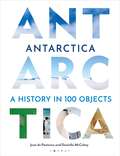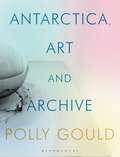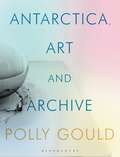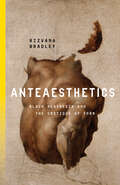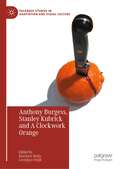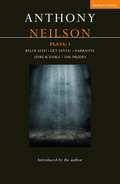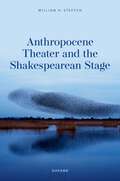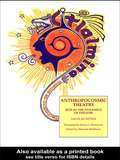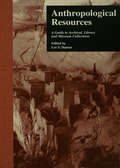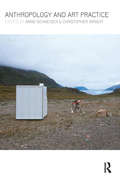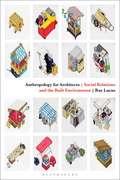- Table View
- List View
Antarctica: A History in 100 Objects
by Jean de Pomereu Daniella McCaheyThis stunning and powerfully relevant book tells the history of Antarctica through 100 varied and fascinating objects drawn from collections around the world.Retracing the history of Antarctica through 100 varied and fascinating objects drawn from collections across the world, this beautiful and absorbing book is published to coincide with the 250th anniversary of the first crossing into the Antarctic Circle by James Cook aboard Resolution, on 17th January 1773. It presents a gloriously visual history of Antarctica, from Terra Incognita to the legendary expeditions of Shackleton and Scott, to the frontline of climate change. One of the wildest and most beautiful places on the planet, Antarctica has no indigenous population or proprietor. Its awe-inspiring landscapes – unknown until just two centuries ago – have been the backdrop to feats of human endurance and tragedy, scientific discovery, and environmental research. Sourced from polar institutions and collections around the world, the objects that tell the story of this remarkable continent range from the iconic to the exotic, from the refreshingly mundane to the indispensable: - snow goggles adopted from Inuit technology by Amundsen - the lifeboat used by Shackleton and his crew- a bust of Lenin installed by the 3rd Soviet Antarctic Expedition- the Polar Star aircraft used in the first trans-Antarctic flight- a sealing club made from the penis bone of an elephant seal- the frozen beard as a symbol of Antarctic heroism and masculinity- ice cores containing up to 800,000 years of climate history This stunning book is both endlessly fascinating and a powerful demonstration of the extent to which Antarctic history is human history, and human future too.
Antarctica, Art and Archive: The Polar Expeditions Of Edward Wilson
by Polly GouldAntarctica, that icy wasteland and extreme environment at the ends of the earth, was - at the beginning of the 20th century - the last frontier of Victorian imperialism, a territory subjected to heroic and sometimes desperate exploration. Now, at the start of the 21st century, Antarctica is the vulnerable landscape behind iconic images of climate change. In this genre-crossing narrative Gould takes us on a journey to the South Pole, through art and archive. Through the life and tragic death of Edward Wilson, polar explorer, doctor, scientist and artist, and his watercolours, and through the work of a pioneer of modern anthropology and opponent of scientific racism, Franz Boas, Gould exposes the legacies of colonialism and racial and gendered identities of the time. Antarctica, the White Continent, far from being a blank - and white - canvas, is revealed to be full of colour. Gould argues that the medium matters and that the practices of observation in art, anthropology and science determine how we see and what we know. Stories of exploration and open-air watercolour painting, of weather experiments and ethnographic collecting, of evolution and extinction, are interwoven to raise important questions for our times. Revisiting Antarctica through the archive becomes the urgent endeavour to imagine an inhabitable planetary future.
Antarctica, Art and Archive
by Polly GouldAntarctica, that icy wasteland and extreme environment at the ends of the earth, was - at the beginning of the 20th century - the last frontier of Victorian imperialism, a territory subjected to heroic and sometimes desperate exploration. Now, at the start of the 21st century, Antarctica is the vulnerable landscape behind iconic images of climate change. In this genre-crossing narrative Gould takes us on a journey to the South Pole, through art and archive. Through the life and tragic death of Edward Wilson, polar explorer, doctor, scientist and artist, and his watercolours, and through the work of a pioneer of modern anthropology and opponent of scientific racism, Franz Boas, Gould exposes the legacies of colonialism and racial and gendered identities of the time. Antarctica, the White Continent, far from being a blank - and white - canvas, is revealed to be full of colour. Gould argues that the medium matters and that the practices of observation in art, anthropology and science determine how we see and what we know. Stories of exploration and open-air watercolour painting, of weather experiments and ethnographic collecting, of evolution and extinction, are interwoven to raise important questions for our times. Revisiting Antarctica through the archive becomes the urgent endeavour to imagine an inhabitable planetary future.
Anteaesthetics: Black Aesthesis and the Critique of Form (Inventions: Black Philosophy, Politics, Aesthetics)
by Rizvana BradleyIn Anteaesthetics, Rizvana Bradley begins from the proposition that blackness cannot be represented in modernity's aesthetic regime, but is nevertheless foundational to every representation. Troubling the idea that the aesthetic is sheltered from the antiblack terror that lies just beyond its sanctuary, Bradley insists that blackness cannot make a home within the aesthetic, yet is held as its threshold and aporia. The book problematizes the phenomenological and ontological conceits that underwrite the visual, sensual, and abstract logics of modernity. Moving across multiple histories and geographies, artistic mediums and forms, from nineteenth-century painting and early cinema, to the contemporary text-based works, video installations, and digital art of Glenn Ligon, Mickalene Thomas, and Sondra Perry, Bradley inaugurates a new method for interpretation—an ante-formalism which demonstrates how black art engages in the recursive deconstruction of the aesthetic forms that remain foundational to modernity. Foregrounding the negativity of black art, Bradley shows how each of these artists disclose the racialized contours of the body, form, and medium, even interrogating the form that is the world itself. Drawing from black critical theory, Continental philosophy, film and media studies, art history, and black feminist thought, Bradley explores artistic practices that inhabit the negative underside of form. Ultimately, Anteaesthetics asks us to think philosophically with black art, and with the philosophical invention black art necessarily undertakes.
Anteaesthetics: Black Aesthesis and the Critique of Form (Inventions: Black Philosophy, Politics, Aesthetics)
by Rizvana BradleyIn Anteaesthetics, Rizvana Bradley begins from the proposition that blackness cannot be represented in modernity's aesthetic regime, but is nevertheless foundational to every representation. Troubling the idea that the aesthetic is sheltered from the antiblack terror that lies just beyond its sanctuary, Bradley insists that blackness cannot make a home within the aesthetic, yet is held as its threshold and aporia. The book problematizes the phenomenological and ontological conceits that underwrite the visual, sensual, and abstract logics of modernity. Moving across multiple histories and geographies, artistic mediums and forms, from nineteenth-century painting and early cinema, to the contemporary text-based works, video installations, and digital art of Glenn Ligon, Mickalene Thomas, and Sondra Perry, Bradley inaugurates a new method for interpretation—an ante-formalism which demonstrates how black art engages in the recursive deconstruction of the aesthetic forms that remain foundational to modernity. Foregrounding the negativity of black art, Bradley shows how each of these artists disclose the racialized contours of the body, form, and medium, even interrogating the form that is the world itself. Drawing from black critical theory, Continental philosophy, film and media studies, art history, and black feminist thought, Bradley explores artistic practices that inhabit the negative underside of form. Ultimately, Anteaesthetics asks us to think philosophically with black art, and with the philosophical invention black art necessarily undertakes.
Antebellum American Pendant Paintings: New Ways of Looking (Routledge Research in Art History)
by Wendy N. IkemotoAntebellum American Pendant Paintings: New Ways of Looking marks the first sustained study of pendant paintings: discrete images designed as a pair. It opens with a broad overview that anchors the form in the medieval diptych, religious history, and aesthetic theory and explores its cultural and historical resonance in the 19th-century United States. Three case studies examine how antebellum American artists used the pendant format in ways revelatory of their historical moment and the aesthetic and cultural developments in which they partook. The case studies on John Quidor’s Rip Van Winkle and His Companions at the Inn Door of Nicholas Vedder (1839) and The Return of Rip Van Winkle (1849) and Thomas Cole’s Departure and Return (1837) shed new light on canonical antebellum American artists and their practices. The chapter on Titian Ramsay Peale’s Kilauea by Day and Kilauea by Night (1842) presents new material that pushes the geographical boundaries of American art studies toward the Pacific Rim. The book contributes to American art history the study of a characteristic but as yet overlooked format and models for the discipline a new and productive framework of analysis focused on the fundamental yet complex way images work back and forth with one another.
Antebellum American Pendant Paintings: New Ways of Looking (Routledge Research in Art History)
by Wendy N. IkemotoAntebellum American Pendant Paintings: New Ways of Looking marks the first sustained study of pendant paintings: discrete images designed as a pair. It opens with a broad overview that anchors the form in the medieval diptych, religious history, and aesthetic theory and explores its cultural and historical resonance in the 19th-century United States. Three case studies examine how antebellum American artists used the pendant format in ways revelatory of their historical moment and the aesthetic and cultural developments in which they partook. The case studies on John Quidor’s Rip Van Winkle and His Companions at the Inn Door of Nicholas Vedder (1839) and The Return of Rip Van Winkle (1849) and Thomas Cole’s Departure and Return (1837) shed new light on canonical antebellum American artists and their practices. The chapter on Titian Ramsay Peale’s Kilauea by Day and Kilauea by Night (1842) presents new material that pushes the geographical boundaries of American art studies toward the Pacific Rim. The book contributes to American art history the study of a characteristic but as yet overlooked format and models for the discipline a new and productive framework of analysis focused on the fundamental yet complex way images work back and forth with one another.
The Antechamber: Toward a History of Waiting (Cultural Memory in the Present)
by Helmut PuffHelmut Puff invites readers to visit societies and spaces of the past through the lens of a particular temporal modality: waiting. From literature, memoirs, manuals, chronicles, visuals, and other documents, Puff presents a history of waiting anchored in antechambers—interior rooms designated and designed for people to linger. In early modern continental Western Europe, antechambers became standard in the residences of the elites. As a time-space infrastructure these rooms shaped encounters between unequals. By imposing spatial distance and temporal delays, antechambers constituted authority, rank, and power. Puff explores both the logic and the experience of waiting in such formative spaces, showing that time divides as much as it unites, and that far from what people have said about early moderns, they approached living in time with apprehensiveness. Unlike how contemporary society primarily views the temporal dimension, to early modern Europeans time was not an objective force external to the self but something that was tied to acting in time. Divided only by walls and doors, waiters sought out occasions to improve their lot. At other times, they disrupted the scripts accorded them. Situated at the intersection of history, literature, and the history of art and architecture, this wide-ranging study demonstrates that waiting has a history that has much to tell us about social and power relations in the past and present.
The Antechamber: Toward a History of Waiting (Cultural Memory in the Present)
by Helmut PuffHelmut Puff invites readers to visit societies and spaces of the past through the lens of a particular temporal modality: waiting. From literature, memoirs, manuals, chronicles, visuals, and other documents, Puff presents a history of waiting anchored in antechambers—interior rooms designated and designed for people to linger. In early modern continental Western Europe, antechambers became standard in the residences of the elites. As a time-space infrastructure these rooms shaped encounters between unequals. By imposing spatial distance and temporal delays, antechambers constituted authority, rank, and power. Puff explores both the logic and the experience of waiting in such formative spaces, showing that time divides as much as it unites, and that far from what people have said about early moderns, they approached living in time with apprehensiveness. Unlike how contemporary society primarily views the temporal dimension, to early modern Europeans time was not an objective force external to the self but something that was tied to acting in time. Divided only by walls and doors, waiters sought out occasions to improve their lot. At other times, they disrupted the scripts accorded them. Situated at the intersection of history, literature, and the history of art and architecture, this wide-ranging study demonstrates that waiting has a history that has much to tell us about social and power relations in the past and present.
Anteros: A Forgotten Myth
by Craig E. StephensonAnteros: A Forgotten Myth explores how the myth of Anteros disappears and reappears throughout the centuries, from classical Athens to the present day, and looks at how the myth challenges the work of Freud, Lacan, and Jung, among others. It examines the successive cultural experiences that formed and inform the myth and also how the myth sheds light on individual human experience and the psychoanalytic process. Topics of discussion include: Anteros in the Italian Renaissance, the French Enlightenment and English Modernism psychologizing Anteros: Freud, Lacan, Girard, and Jung three anterotic moments in a consulting room. This book presents an important argument at the boundaries of the disciplines of analytical psychology, psychoanalysis, art history, and mythology. It will therefore be essential reading for all analytical psychologists and psychoanalysts as well as art historians and those with an interest in the meeting of psychoanalytic thought and mythology.
Anteros: A Forgotten Myth
by Craig E. StephensonAnteros: A Forgotten Myth explores how the myth of Anteros disappears and reappears throughout the centuries, from classical Athens to the present day, and looks at how the myth challenges the work of Freud, Lacan, and Jung, among others. It examines the successive cultural experiences that formed and inform the myth and also how the myth sheds light on individual human experience and the psychoanalytic process. Topics of discussion include: Anteros in the Italian Renaissance, the French Enlightenment and English Modernism psychologizing Anteros: Freud, Lacan, Girard, and Jung three anterotic moments in a consulting room. This book presents an important argument at the boundaries of the disciplines of analytical psychology, psychoanalysis, art history, and mythology. It will therefore be essential reading for all analytical psychologists and psychoanalysts as well as art historians and those with an interest in the meeting of psychoanalytic thought and mythology.
An Anthology of Contemporary Bengali Plays by Bratya Basu
by Bratya BasuThis anthology of six selected plays, written between 2000 and 2020 by Bratya Basu, winner of the Sahitya Akademi Award 2021, is the first collection of Bengali plays that blends avant-garde, pop and traditional cultures with contemporary dramatic themes. The six plays, freshly translated into English, each bring a uniquely Bengali and Indian perspective to the intermingling of past and present, global and local, and magical and real in a postmodern pastiche about India today. The collection is divided into three thematic sections: 1) 'Poignant Challenges, Soulful Remorse' examines power in Indian politics, religion, and family. 2) '(In)visible Boundaries, (Un)democratic Choices' explores the relationship among democracy, nation building, and the role of women in intergenerational political struggle. 3) 'Intimately Political, Politically Intimate' navigates queer identity, mental health and the fabulation of modern Bengali life in a 21st-century India straddling the progressive politics that removed section 377 and Hindu nationalisms that stoke new conservatisms.
An Anthology of Contemporary Bengali Plays by Bratya Basu
by Bratya BasuThis anthology of six selected plays, written between 2000 and 2020 by Bratya Basu, winner of the Sahitya Akademi Award 2021, is the first collection of Bengali plays that blends avant-garde, pop and traditional cultures with contemporary dramatic themes. The six plays, freshly translated into English, each bring a uniquely Bengali and Indian perspective to the intermingling of past and present, global and local, and magical and real in a postmodern pastiche about India today. The collection is divided into three thematic sections: 1) 'Poignant Challenges, Soulful Remorse' examines power in Indian politics, religion, and family. 2) '(In)visible Boundaries, (Un)democratic Choices' explores the relationship among democracy, nation building, and the role of women in intergenerational political struggle. 3) 'Intimately Political, Politically Intimate' navigates queer identity, mental health and the fabulation of modern Bengali life in a 21st-century India straddling the progressive politics that removed section 377 and Hindu nationalisms that stoke new conservatisms.
Anthony Burgess, Stanley Kubrick and A Clockwork Orange (Palgrave Studies in Adaptation and Visual Culture)
by Matthew Melia Georgina OrgillThis book brings together a diverse range of contemporary scholarship around both Anthony Burgess’s novel (1962) and Stanley Kubrick’s film, A Clockwork Orange (US 1971; UK 1972). This is the first book to deal with both together offering a range of groundbreaking perspectives that draw on the most up to date, contemporary archival and critical research carried out at both the Stanley Kubrick Archive, held at University of the Arts London, and the archive of the International Anthony Burgess Foundation. This landmark book marks both the 50th anniversary of Kubrick’s film and the 60th anniversary of Burgess’s novel by considering the historical, textual and philosophical connections between the two. The chapters are written by a diverse range of contributors covering such subjects as the Burgess/Kubrick relationship; Burgess’s recently discovered ‘sequel’ The Clockwork Condition; the cold war context of both texts; the history of the script; the politics of authorship; and the legacy of both—including their influence on the songwriting and personas of David Bowie!
Anthony Neilson Plays: Relocated; Get Santa!; Narrative; Unreachable; The Prudes (Contemporary Dramatists)
by Anthony NeilsonAnthony Neilson is often described as one of the most exciting and challenging voices in contemporary British theatre. For over two decades he has acquired a reputation for innovation and experimentation in both writing and directing having worked with companies such as The Royal Court, The RSC and the National Theatre. This third play collection of his most recent major works brings together five plays in publication for the first time, offering an important documentary of his original work since 2008. Relocated (2008) originally premiered at the Royal Court, directed by the author, where it was described as a “sinister mystery” play and “not an experience for the faint-hearted…morally challenging and riveting…leaves an indelible stain on the memory” (The Times). Get Santa! (2010) is a magical, musical and mischievous Christmas show with a fresh moral featuring music by Nick Powell. It's Christmas Eve but Holly isn't happy. All she's ever wanted from Santa is to meet her real Dad for the first time. And every time, Santa's failed to deliver, bringing lots of useless presents instead. Well, Holly's had enough. This year she has a plan. She's going to wait up and trap Santa when he arrives and get from him the only present she's ever wanted. Narrative (2013) originally premiered at the Royal Court Theatre Upstairs. Devised throughout rehearsal with a seven-strong cast it's a play about storytelling and the narratives of our everyday lives.Unreachable (2016) was described as an “intoxicatingly chaotic comedy” (Time Out) which follows a film director on an obsessive quest to capture the perfect light. Originally running at the Royal Court Theatre in a production that starred Matt Smith, it broke boundaries by offering audiences a digital insight into the rehearsal process through online content which documented and shaped the devising process. The Prudes (2018) is a comedy about relationships in the current sexual climate; and a vicious satire on the male response to it. Jess and Jimmy haven't done it in a year. Fourteen months and four days to be exact. It's definitely not the seven year itch – they've been together nine. Now they're coming together in a last-ditch effort to re-boot their sex life and save their relationship. But a lot has changed in a year; for them and for the world. Described as a “smart, sketchy, amusing, awkward, stimulating two-hander” (The Times), it originally premiered at the Royal Court Upstairs.Published to coincide with his adaptation of The Tell-Tale Heart at the National Theatre in December 2018, this play collection is an important and unique anthology of a major international voice of contemporary theatre.
Anthony Neilson Plays: Relocated; Get Santa!; Narrative; Unreachable; The Prudes (Contemporary Dramatists)
by Anthony NeilsonAnthony Neilson is often described as one of the most exciting and challenging voices in contemporary British theatre. For over two decades he has acquired a reputation for innovation and experimentation in both writing and directing having worked with companies such as The Royal Court, The RSC and the National Theatre. This third play collection of his most recent major works brings together five plays in publication for the first time, offering an important documentary of his original work since 2008. Relocated (2008) originally premiered at the Royal Court, directed by the author, where it was described as a “sinister mystery” play and “not an experience for the faint-hearted…morally challenging and riveting…leaves an indelible stain on the memory” (The Times). Get Santa! (2010) is a magical, musical and mischievous Christmas show with a fresh moral featuring music by Nick Powell. It's Christmas Eve but Holly isn't happy. All she's ever wanted from Santa is to meet her real Dad for the first time. And every time, Santa's failed to deliver, bringing lots of useless presents instead. Well, Holly's had enough. This year she has a plan. She's going to wait up and trap Santa when he arrives and get from him the only present she's ever wanted. Narrative (2013) originally premiered at the Royal Court Theatre Upstairs. Devised throughout rehearsal with a seven-strong cast it's a play about storytelling and the narratives of our everyday lives.Unreachable (2016) was described as an “intoxicatingly chaotic comedy” (Time Out) which follows a film director on an obsessive quest to capture the perfect light. Originally running at the Royal Court Theatre in a production that starred Matt Smith, it broke boundaries by offering audiences a digital insight into the rehearsal process through online content which documented and shaped the devising process. The Prudes (2018) is a comedy about relationships in the current sexual climate; and a vicious satire on the male response to it. Jess and Jimmy haven't done it in a year. Fourteen months and four days to be exact. It's definitely not the seven year itch – they've been together nine. Now they're coming together in a last-ditch effort to re-boot their sex life and save their relationship. But a lot has changed in a year; for them and for the world. Described as a “smart, sketchy, amusing, awkward, stimulating two-hander” (The Times), it originally premiered at the Royal Court Upstairs.Published to coincide with his adaptation of The Tell-Tale Heart at the National Theatre in December 2018, this play collection is an important and unique anthology of a major international voice of contemporary theatre.
Anthropocene Theater and the Shakespearean Stage
by William H. SteffenAnthropocene Theater and the Shakespearean Stage revises the anthropocentric narrative of early globalization from the perspective of the non-human world in order to demonstrate Nature's agency in determining ecological, economic, and colonial outcomes. It welcomes readers to reimagine theater history in broader terms, and to account for more non-human and atmospheric players in the otherwise anthropocentric history of Shakespearean performance. This book analyses plays, horticultural manuals, cosmetic recipes, Puritan polemics, and travel writing in order to demonstrate how the material practices of the stage both catalyze and resist early forms of globalization in an ecological arena. William Steffen addresses the role of an understudied ecological performance history in determining Shakespeare's iconic cultural status, and models how non-human players have undermined Shakespeare's authoritative role in colonial discourse. Finally, this book makes a celebratory argument for the humanities in the age of climate change, and invites interdisciplinary engagement a research community that is compelled to find strategies for cultivating a hopeful tomorrow amidst unprecedented anthropogenic environmental changes.
Anthropocene Theater and the Shakespearean Stage
by William H. SteffenAnthropocene Theater and the Shakespearean Stage revises the anthropocentric narrative of early globalization from the perspective of the non-human world in order to demonstrate Nature's agency in determining ecological, economic, and colonial outcomes. It welcomes readers to reimagine theater history in broader terms, and to account for more non-human and atmospheric players in the otherwise anthropocentric history of Shakespearean performance. This book analyses plays, horticultural manuals, cosmetic recipes, Puritan polemics, and travel writing in order to demonstrate how the material practices of the stage both catalyze and resist early forms of globalization in an ecological arena. William Steffen addresses the role of an understudied ecological performance history in determining Shakespeare's iconic cultural status, and models how non-human players have undermined Shakespeare's authoritative role in colonial discourse. Finally, this book makes a celebratory argument for the humanities in the age of climate change, and invites interdisciplinary engagement a research community that is compelled to find strategies for cultivating a hopeful tomorrow amidst unprecedented anthropogenic environmental changes.
Anthropocosmic Theatre: Rite in the Dynamics of Theatre
by Nichos NunezFirst published in 1997. Routledge is an imprint of Taylor & Francis, an informa company.
Anthropocosmic Theatre: Rite in the Dynamics of Theatre
by Nichos NunezFirst published in 1997. Routledge is an imprint of Taylor & Francis, an informa company.
Anthropological Resources: A Guide to Archival, Library, and Museum Collections (Sociology/Psychology/Reference)
by Lee S. DuttonFirst published in 1999. Routledge is an imprint of Taylor & Francis, an informa company.
Anthropological Resources: A Guide to Archival, Library, and Museum Collections (Sociology/Psychology/Reference)
by Lee S. Dutton Michele Calhoun Francis X. Grollig S. J. Thomas L. Mann Hans E. Panofsky Margo L. Smith Sol Tax Christopher WintersFirst published in 1999. Routledge is an imprint of Taylor & Francis, an informa company.
Anthropology and Art Practice
by Arnd Schneider Christopher WrightAnthropology and Art Practice takes an innovative look at new experimental work informed by the newly-reconfigured relationship between the arts and anthropology. This practice-based and visual work can be characterised as 'art-ethnography'. In engaging with the concerns of both fields, this cutting-edge study tackles current issues such as the role of the artist in collaborative work, and the political uses of documentary. The book focuses on key works from artists and anthropologists that engage with 'art-ethnography' and investigates the processes and strategies behind their creation and exhibition.The book highlights the work of a new generation of practitioners in this hybrid field, such as Anthony Luvera, Kathryn Ramey, Brad Butler and Karen Mizra, Kate Hennessy and Jennifer Deger, who work in a diverse range of media - including film, photography, sound and performance. Anthropology and Art Practice suggests a series of radical challenges to assumptions made on both sides of the art/anthropology divide and is intended to inspire further dialogue and provide essential reading for a wide range of students and practitioners.
Anthropology and Art Practice: Contemporary Ethnographic Practice (Contemporary Ethnographic Practice Ser.)
by Christopher Wright Arnd SchneiderAnthropology and Art Practice takes an innovative look at new experimental work informed by the newly-reconfigured relationship between the arts and anthropology. This practice-based and visual work can be characterised as 'art-ethnography'. In engaging with the concerns of both fields, this cutting-edge study tackles current issues such as the role of the artist in collaborative work, and the political uses of documentary. The book focuses on key works from artists and anthropologists that engage with 'art-ethnography' and investigates the processes and strategies behind their creation and exhibition.The book highlights the work of a new generation of practitioners in this hybrid field, such as Anthony Luvera, Kathryn Ramey, Brad Butler and Karen Mizra, Kate Hennessy and Jennifer Deger, who work in a diverse range of media - including film, photography, sound and performance. Anthropology and Art Practice suggests a series of radical challenges to assumptions made on both sides of the art/anthropology divide and is intended to inspire further dialogue and provide essential reading for a wide range of students and practitioners.
Anthropology for Architects: Social Relations and the Built Environment
by Ray LucasWhat can architects learn from anthropologists? This is the central question examined in Anthropology for Architects – a survey and exploration of the ideas which underpin the correspondence between contemporary social anthropology and architecture. The focus is on architecture as a design practice. Rather than presenting architectural artefacts as objects of the anthropological gaze, the book foregrounds the activities and aims of architects themselves. It looks at the choices that designers have to make – whether engaging with a site context, drawing, modelling, constructing, or making a post-occupancy analysis – and explores how an anthropological view can help inform design decisions. Each chapter is arranged around a familiar building type (including the studio, the home, markets, museums, and sacred spaces), in each case showing how anthropology can help designers to think about the social life of buildings at an appropriate scale: that of the individual life-worlds which make up the everyday lives of a building's users. Showing how anthropology offers an invaluable framework for thinking about complex, messy, real-world situations, the book argues that, ultimately, a truly anthropological architecture offers the potential for a more socially informed, engaged and sensitive architecture which responds more directly to people's needs.Based on the author's experience teaching as well as his research into anthropology by way of creative practice, this book will be directly applicable to students and researchers in architecture, landscape, urban design, and design anthropology, as well as to architectural professionals.
